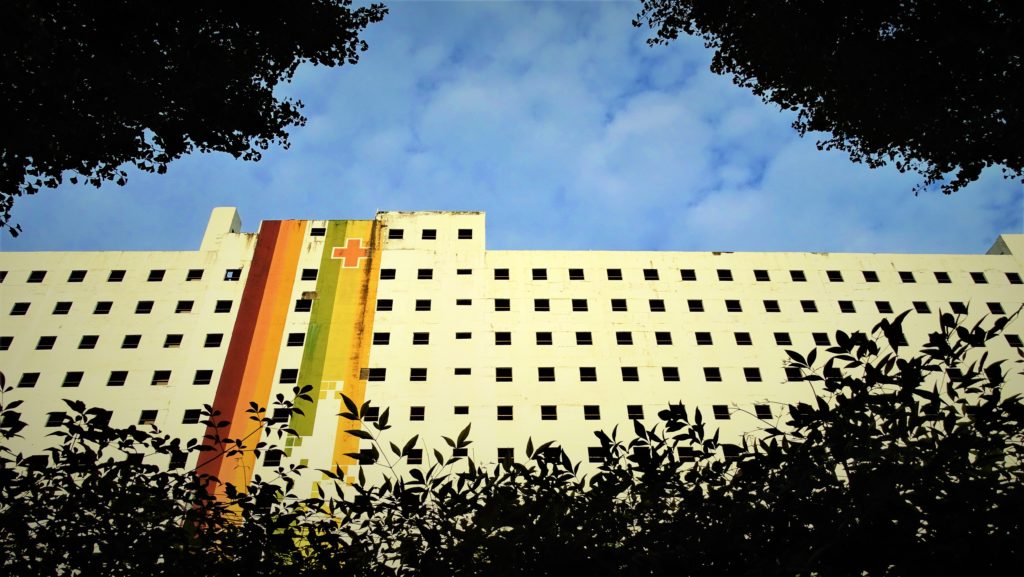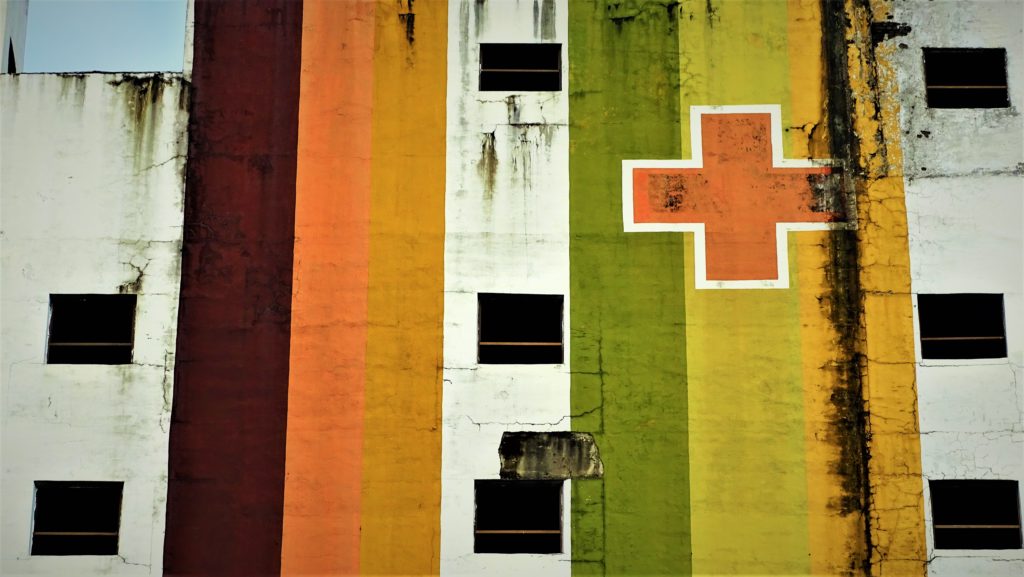That Other Creepy Gwangju Hospital
Written and photographed by Isaiah Winters
Gwangju is home to interesting eyesores of various sizes and vintages. Among them, few are larger, older, and have a better story to tell than Seojin Hospital (서진병원) in Juwol-dong, Nam-gu. This 12-story concrete shell is one of those desolate behemoths that, once seen, cannot be unseen. Its bleak exterior’s only embellishment is a colorblind rainbow of purple, peach, golden-brown, white, army green, baby vomit green, and rusty gold – a testament to the technicolor hell-scape that was the 1980s. The whole thing assaults the eyes and begs answers to the who, what, when, where, why, and how of it all.

As a preface, it’s important to note that Seojin Hospital isn’t the same as the well-known Gonjiam Psychiatric Hospital, a supposedly haunted site located in a city just outside of Seoul that also happens to be called Gwangju. The latter hospital was featured in the 2018 Korean horror film Gonjiam: Haunted Asylum and was included among CNN’s 7 of the freakiest places on the planet back in 2012. The international attention has become a nuisance for nearby residents, something my friend and fellow urban explorer Ron wrote about in The Korea Times back in April. Seojin Hospital, by contrast, isn’t well known and doesn’t have any ghostly backstory, but it does have a shocking history intertwined with the embezzlement of 100 billion won and a school’s failure to address wide-scale sexual harassment of high school girls, making it that other creepy Gwangju hospital.
Construction on Seojin Hospital began in 1982 and was officially suspended in 1988 due to “financial difficulties” on the part of the owner (more on him soon). Originally, the hospital was intended to be an affiliate of Seonam University’s College of Medicine, but that clearly never panned out. According to one source, the unfinished block of concrete and rebar was so hideous that Gwangju City decided to paint it using taxpayer money so that it wouldn’t hurt the city’s image during a certain international competition (possibly the 1988 Olympics or the 2002 World Cup, though the article doesn’t specify).[1] In the end, Seojin Hospital was only one minor part of a far larger house of cards brought down by the serial embezzlement of education kingpin Lee Hong-ha.
Born in Goheung and a graduate of Chosun University, Lee rose to prominence in the 1980s after he founded a few private high schools in Gwangju and Naju, including Daegwang Girls’ High School (대광여자고등학교) and Seojin Girls’ High School (서진여자고등학교) in Juwol-dong, Nam-gu. Bit by bit, the ambitious Lee would embezzle tuition fees to help build the adjacent monstrosity that is Seojin Hospital. However, the hospital seems to have become an afterthought once Lee decided to focus his attention on still more ambitious projects: full-on universities. He would eventually build six of them, half of which are now defunct.

To gather the enormous sums needed to found entire universities, Lee would play a financial shell game whereby he’d first embezzle tuition fees from his private high schools and then use those monies to set up a university. The tuition fees collected from the incoming university students would then be embezzled again to start yet another university, with some of the funds going back to the original high schools. Half a dozen universities and over 100 billion won’s worth of embezzlement later, the scheme finally caught up to Lee when, in 2012, he was arrested and sentenced to nine years (and later an additional six months) in Gwangju Prison.
Among the latest updates on Lee is a story from August 2015, when he had to visit the intensive care unit at Chonnam National University Hospital after getting badly beaten up by another inmate. For some unknown reason, the fellow prisoner fractured the then 77-year-old’s upper and lower jaws and a right-side rib, in addition to leaving him with a subarachnoid hemorrhage caused by head trauma. During his treatment, Lee was also found to have peritoneal bleeding caused by liver damage.[2] In short, things aren’t looking up for Lee these days.
But the story doesn’t end there. In late August of this year, JTBC, one of South Korea’s major broadcasting companies, aired an investigative report on Lee’s “cartel of silence” (침묵의 카르텔), which involved the ensnarement of teachers in his embezzlement schemes and a massive failure to address the extensive sexual harassment taking place at one of his high schools. The episode, hosted by journalist Lee Gyu-yeon on the show Spotlight (스포트라이트), examines Lee’s “cartel” in great detail and is the main source for much of the information in this article.[3]
The episode explains that in order to raise additional funds for his numerous development projects, Lee would (often successfully) pressure some of his teachers to take out bank loans and then hand the money off to him. This made many teachers reluctant to raise red flags over Lee’s misappropriation of school funds, as they were now complicit in his embezzlement schemes. In turn, when it later became apparent that numerous teachers were notorious for sexually harassing their students, no corrective actions were taken – hence the “cartel of silence.”

Allegations from students include jarring accounts of certain teachers repeatedly engaging in lewd conduct, such as bawdy humor, inappropriate touching, and rumors of worse. According to the Spotlight report, even graduates from 6-7 years prior came up with similar names of teachers who were the worst harassers. Far from being purely passive in their mistreatment, one group of students is said to have written a letter of appeal to a particularly egregious teacher with intent to release it to a broadcaster, but the teacher caught wind of things and threatened to give the students bad comments in their student record books, which could have derailed their hopes for higher education. In fact, the fear of getting a bad student record for speaking out has made the process of gathering student testimonies a challenge.
In light of the #MeToo movement that has recently been sweeping through much of South Korea, and thanks to Lee’s imprisonment, there’s been a bit of wiggle room for school reforms. For example, a survey was conducted in the summer by the Gwangju Metropolitan City’s Office of Education in conjunction with school officials to identify the most culpable teachers, 16 of whom have already been fired. Following this, a police investigation uncovered three additional teachers worthy of blame. In total, two of these 19 teachers have been arrested. The police have said that about 70 percent of the 180 students involved with the investigation have come forward and offered testimonies.[4] As this is an ongoing case, hopefully more students will feel confident enough to come forward so justice can be fully meted out.
As for Seojin Hospital itself, the property was auctioned off in 2016 to a real estate investment company for 4.5 billion won. A wrinkle has since emerged over the small, two-way road which runs through the auctioned property and is the only way for transporting the 1,800 students to school. The winning bidder has filed a lawsuit against Lee’s company, Hongbok Academy (홍복학원), seeking nearly 7 million won per month for the road’s use, in addition to 319 million won to cover the hospital’s demolition.[5] That little slice of litigation heaven is about as much of the ongoing fiasco as I can fit in this article.
To learn that all of this has been taking place within the hulking, 30-year-old shadow of Seojin Hospital has come as a surprise, to put it mildly. Though admittedly it’s an ugly husk of a building, I’ll never look at the place with the same apathy as before.
Sources
[1] Pak Yeong-rae. (2017, April 18). “30년 도심 흉물” 광주 서진병원 처리 더 꼬여가네. Retrieved from the News 1 Korea website: http://news1.kr/articles/?2969711
[2] Hyeong Minu & Son Sangwon. (2015, August 22). “사학비리” 이홍하 교도소서 동료 재소자에 맞아 중상(종합). Retrieved from the Yonhap News website: http://www.yonhapnews.co.kr/bulletin/2015/08/22/0200000000AKR20150822042451054.HTML
[3] Lee Gyu-yeon. (2018, August 30). 이규연의 스포트라이트 162회 다시보기 [Video]. Retrieved from the JTBC website: http://vod.jtbc.joins.com/player/program/ep20027215
[4] Jeong Dae-ha. (2018, September 17). 남성 교사 38명 중 18명이 가해…광주 모 여고 “스쿨 미투.” Retrieved fron the Hankyoreh website: https://www.msn.com/ko-kr/news/national/남성-교사-38명-중-18명이-가해…광주-모-여고-‘스쿨-미투’/ar-BBNqTlo
[5] Park Jun-bae. (2017, June 6). 학교 통학로 통행금지까지…서진병원 부지 갈등 “확산.” Retrieved from the News 1 Korea website: http://news1.kr/articles/?3013619
The Author
Originally from Southern California, Isaiah Winters first came to Gwangju in 2010. He recently returned to South Korea after completing his MA in Eastern Europe and is currently the chief proofreader for the Gwangju News. He enjoys writing, political science, and urban exploring.







